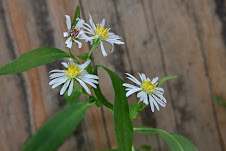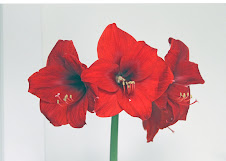Sunday, October 21, 2012
Jerusalem Artichoke (Heliantus tuberosus)
This is a wildflower weed that I am always trying to eradicate from my yard. I break off the seed tops and dig up the roots to no avail. This monster is called a Jerusalem artichoke (Helianthus tuberosus). However, the plant is not related to the artichoke or Jerusalem, but is a species of sunflower. Classified in the sunflower family the plant is distinguished from other species of sunflowers by underground tubers.
In August bright yellow flower heads are produced at ends of the stems. Each flower contains 8 to 20 outer yellow flowers or ray flowers that enclose the dark yellow to brown disk flowers.
The first leaves are opposite and covered with short hairs. These large leaves range from 4 to 10 inches long and 1 ½ to 5 inches wide. Mature leaves are longer and taper to a point with the upper leaves alternate on the stem. All leaves have toothed margins.
The Jerusalem artichoke is also called sunroot, sunchoke, earth apple or topinambour. The tuber is used as a root vegetable. This perennial may grow up to 10 feet tall and is found throughout the eastern half of the United States and along the Pacific coast.
The wildflower was first cultivated by Native American. In 1805 Lewis & Clark dined on the tubers. A French explorer noted that the edible tuber tasted like an artichoke. In the 2002 Nice Festival for the Heritage of the French Cuisine the Jerusalem artichoke was awarded the “best soup vegetable”.
The tuber can be thinly sliced and added to a salad or steamed in a stew. The tubers may cause flatulence. Unlike potatoes, they do not contain starch, but inulin, a fiber, that changes into a natural sugar.
The tubers are highly nutritious. Jerusalem artichokes have 650 mg potassium per 1 cup (150g) serving. They are also high in iron, and contain 10-12% of the US RDA of fiber, niacin, thiamine, phosphorus and copper. I have bought sunchokes in grocery stores in California.
In Germany the tubers are used to make a spirit called “Jerusalem artichoke brandy”.
You might want to try Jerusalem artichokes tubers. However, the quality of the edible tubers degrades unless the plants are dug up and replanted in fertile soil. Better to wait until Jan. or Feb. before digging up the tuber. This gives time for the tuber to become sweeter. Beware; a small piece of tuber will grow if left in the ground, making the hardy plant a potential weed. Even a piece of a root can make an additional 75 to as many as 200 tubers by fall's end.
Jerusalem artichokes can be used as animal feed, but must be washed before being fed to most animals. Except pigs, which forage and safely eat them directly from the soil. Does anyone have some pigs they can lend me?
For additional info "http://http://www.ppws.vt.edu/scott/weed_id/heltu.htm" and
"http://en.wikipedia.org/wiki/Jerusalem_artichoke#cite_note-purdue-1"
Subscribe to:
Comments (Atom)




















LP_gardening_2666.jpg)
LP_gardening_2668.jpg)

LP_garden_2819.jpg)

LP_flower_0563.jpg)
LP_flower_0577.jpg)
LP_flower_0545.jpg)
LP_flower_0555.jpg)
LP_flower_0539.jpg)
LP_dog_0470.jpg)
LP_snow_0467.jpg)
LP_dog_0349.jpg)
LP_tree_8153.jpg)
LP_5028.jpg)
LP_flowers_3940.jpg)

LP-grass_0889.jpg)
LP_redfox_1651.jpg)
LP_squirrel_6978.jpg)
LP_flower_6936.jpg)
LP_squirrel_6864.jpg)
LP-deer_4773.jpg)
LP_4521.jpg)
LP_1251.jpg)
LP_4585.jpg)
LP_3784.jpg)
LP_3759.jpg)
LP_3811.jpg)
LP_3816.jpg)
LP_3847.jpg)
LP_0870.jpg)
LP_4183.jpg)
LP_0891.jpg)
LP_3175.jpg)
LP_3577.jpg)

LP_3068.jpg)
LP_3058.jpg)
LP_3562.jpg)
LP_0118.jpg)
LP_3407.jpg)
LP_3150.jpg)
LP_3011+(2).jpg)
LP_3020.jpg)
LP_2830.jpg)
LP_2782.jpg)
LP_2828.jpg)
LP_1746.jpg)
LP_2648.jpg)
LP_2666.jpg)
LP_2668.jpg)
LP_2493.jpg)
LP_2611crop.jpg)


LP_2588.jpg)






LP_2126.jpg)
LP_2122.jpg)





